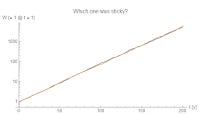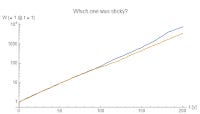Is micro stickiness enough?
Many people look at this diagram from the SF Fed (see the discussion here) and see evidence of sticky wages at the micro level:

That spike at zero wage change changes from 12% to 16% and the result is 10% unemployment and a recession. Or so says Scott Sumner today, Paul Krugman in 2012, and commenter Bill here.
The question is -- can you tell the difference between the path of aggregate wages using those two empirical distributions to generate wage changes for the population? Not really. Here is the empirical distribution:

And here are several aggregate paths generated from that distribution:




Hard to tell, right? The blue line is the sticky one. And that's after 200 years of one being in a recession and one not! (The distribution from the SF Fed used annual changes, so each time step is a year.) It's only a few hundred people, not the millions in the labor force. So what would we expect if we did look at millions of agents? Here are the empirical distributions generated from more points:

The difference in the average of these two distributions is about 0.1 to 0.2 percentage points, so the difference in total aggregate wage change between populations with these two distributions is about 15 billion dollars = (0.2% x 7 trillion dollars). The US economy suffers a recession -- losing a several percent of GDP -- because the market cannot unstick 15 billion dollars?
That's why I think it's not the micro-stickiness of the zero bin, but rather the macro stickiness of being unable to coordinate a change in the whole distribution. The zero bin does contribute! In the previous link, it seems the observed 4% change in the zero bin would account for about 2% of the 8% NGDP loss (but from the entropy mechanism -- not lack of adjustment, they could all jump in the 1% growth bin or 5% growth bin and get the exact same effect on economic entropy that I wrote about again today). So the total effect looks like it's a bit of micro stickiness (but not for traditional economic reasons), but mostly macro stickiness.



